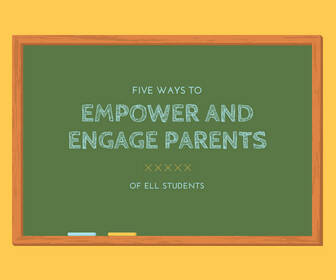Written by Dr. Stephanie Knight
Parental involvement may be the strongest predictor of a child receiving a solid education. This extends more importantly to ELL students who are challenged by language barriers. This home/school partnership with ELL families may be more challenging and it goes well beyond language differences – economic struggle and family mobility are more common within the ELL population. Also, many ELL families are not familiar with the school system and may be intimidated to speak up. The basic idea of even reading to their children may be a foreign concept. It becomes the responsibility of an educator to empower and engage parents of ELL’s to ensure not only a smooth transition into a new language and the school but also to future success.
1. Connect Immediately
We must be proactive in connecting with all of our students but especially our ELL families. Once you get your students’ information, write out a letter and have it translated into the language of that family. Include information about yourself, goals for your class, your availability and open-door policies, and that you will follow-up within a week to meet them personally.
Then stay true to your word and follow up with a personal phone call. Make sure you have a translator nearby to help you communicate. The goal of your call should only be to introduce yourself personally and to invite them in to have an initial conference. The face-to-face meeting needs to be your goal. If you leave a message, speak slowly so one may translate it.
2. Educate with Love
At the face to face meeting, ask the parent, “What do you want to see for your child? How can we here at school support you?” If the child is not yet in high school, asking what they are hoping to see before they pass on to high school opens the door for communication about goals for the student. Having loving motives is key because many of these families don’t have much time to participate, nor do they know the importance of being involved. Remember, we want to empower and encourage our parents to see a bright future for their child, so asking these questions may prompt these vital conversations.
3. Equip and Provide
Providing opportunities for families to come into the school after hours must occur. Holding parent education workshops can be a fun way to do this. Then, employ the teachers in the school to demonstrate useful techniques for reading to children, at-home games to do with children, and tips about helping with homework. Providing food and childcare will improve attendance.
Encourage the parents to read to their child in that native language. Even providing a book bag filled with books takes away any objection. We want to keep their culture alive and celebrate it, and helping the parents help their children needs to be a priority. If parents don’t have the book in their language or if they are illiterate, teachers can encourage families to share oral stories. Any activities to do with their children must be shared and modeled at these events.
4. Tap into family’s funds of knowledge
Funds of Knowledge is a term devised by Luis Moll (1992) stressing the importance of prior experiences students add to the classroom. What this means is that we must proactively bridge the gap between home and school by reaching out to parents in finding what they can contribute culturally to the classroom.
Maybe a parent can be a guest speaker to share traditions or celebrations. They may also know others in the community who could come in and share. The key is to find opportunities for ELL families to become involved in the classroom in the way that fits them. Another idea is to hold a poetry night or a way to share some student work, and then the students and families can contribute food and/or music to celebrate their culture. This way you are accomplishing celebrating work as well as getting the families involved.
5. Prepare a long-term plan for ELL parental involvement.
It doesn’t stop after the first week of school. We must be proactive and creative through the year. Start a collaboration with your local community organizations. This may mean calling places in your area and coming up with ideas on how you can support each other. There are many community organizations that exist to support ELL students and families. They can offer tutoring, social services, medical needs, language classes for adults and citizenship classes.
After you find community services, make a brochure or handout for your ELL families and make it available. The more we can do through the year, the more our families will want to get involved and stay involved in their child’s future education.
Remember, we are looking to encourage and then empower our ELL families. The first and most important step is reaching out and building those relationships early then maintaining and growing them through the year. Promoting the contributions of ELL families will only help schools work for the benefit of the entire community.
Dr. Stephanie Knight is an experienced 7th and 8th grade English language arts educator. She taught in Title One schools for eight years—helping them grow from underperforming to excelling—and then in an independent school for four years. Knight is now is part of Grand Canyon University’s adjunct faculty where she teaches graduate-level education and reading courses.








